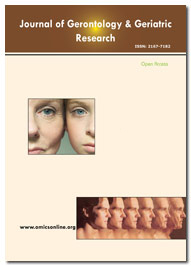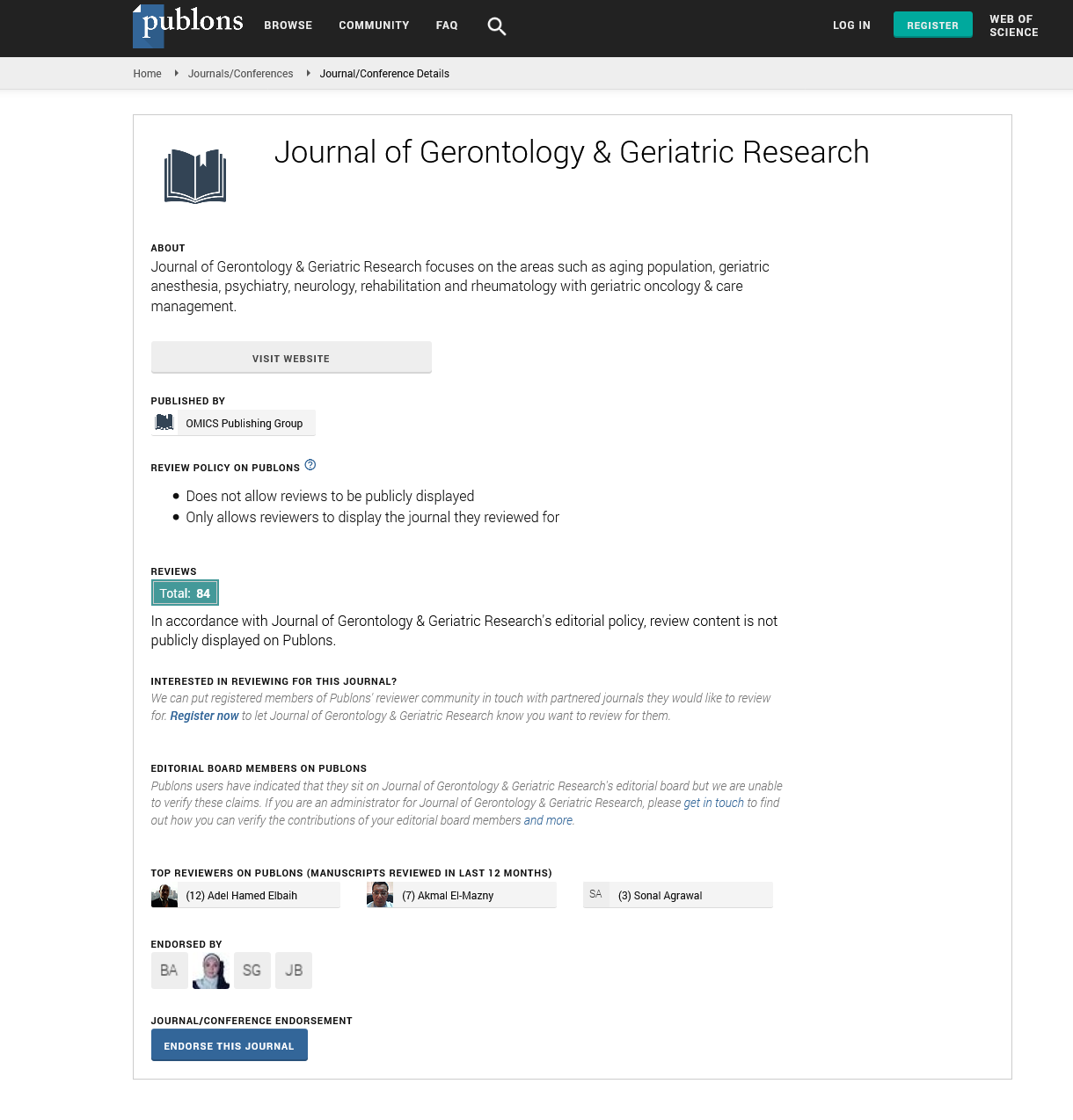Indexed In
- Open J Gate
- Genamics JournalSeek
- SafetyLit
- RefSeek
- Hamdard University
- EBSCO A-Z
- OCLC- WorldCat
- Publons
- Geneva Foundation for Medical Education and Research
- Euro Pub
- Google Scholar
Useful Links
Share This Page
Journal Flyer

Open Access Journals
- Agri and Aquaculture
- Biochemistry
- Bioinformatics & Systems Biology
- Business & Management
- Chemistry
- Clinical Sciences
- Engineering
- Food & Nutrition
- General Science
- Genetics & Molecular Biology
- Immunology & Microbiology
- Medical Sciences
- Neuroscience & Psychology
- Nursing & Health Care
- Pharmaceutical Sciences
Commentary - (2024) Volume 13, Issue 5
Chronic Pain Management in Older Adults: Current Strategies and Emerging Therapies
Tim Chung*Received: 02-Oct-2024, Manuscript No. jggr-24-27663; Editor assigned: 04-Oct-2024, Pre QC No. P-27663; Reviewed: 17-Oct-2024, QC No. Q-27663; Revised: 23-Oct-2024, Manuscript No. R-27663; Published: 30-Oct-2024, DOI: 10.35248/2167-7182.2024.13.753
Introduction
Chronic pain is a prevalent and complex condition among older adults, affecting their physical, emotional, and social well-being. It can result from various causes, including degenerative diseases, neuropathies, musculoskeletal disorders, and previous injuries. As the global population continues to age, effective chronic pain management in older adults has become an increasingly critical healthcare priority. However, managing chronic pain in these demographic presents’ unique challenges due to physiological changes that accompany aging, polypharmacy, comorbidities and the increased risk of adverse treatment outcomes. This article explores current strategies for managing chronic pain in older adults, evaluates their effectiveness, and discusses emerging therapies that may offer new hope for better outcomes [1].
Description
Current strategies for managing chronic pain in older adults include a combination of pharmacological, non-pharmacological, and interventional approaches. Pharmacological treatments, such as analgesics (opioids and non-opioid medications), are commonly used but require careful consideration of their risks and side effects, especially in older patients who may be more susceptible to drug interactions, cognitive impairment, or dependency. Non-pharmacological therapies, including physical therapy, Cognitive-Behavioral Therapy (CBT), acupuncture, and mindfulness practices, have shown promise in alleviating pain while minimizing side effects. Interventional treatments such as nerve blocks, spinal cord stimulation, and joint injections can provide relief for more localized or severe pain conditions.
A multidisciplinary approach that incorporates these methods is often considered the gold standard, with the goal of reducing pain intensity, improving functionality, and enhancing the patient’s quality of life. Beyond traditional treatments, the importance of addressing the psychological and emotional dimensions of chronic pain is increasingly recognized [2]. Older adults with chronic pain often experience depression, anxiety, and social isolation, which can exacerbate the pain experience. Psychological interventions such as CBT, Acceptance and Commitment Therapy (ACT), and relaxation techniques are integral components of a comprehensive pain management plan. These therapies help individuals reframe their pain perception, improve coping mechanisms, and reduce stress, ultimately contributing to better pain outcomes. Social support, physical activity, and lifestyle modifications, including weight management and sleep optimization, also play crucial roles in improving pain management in this population. Integrating these approaches into a holistic treatment plan can lead to more sustainable pain relief and better overall health outcomes for older adults [3].
Emerging therapies in chronic pain management focus on innovative approaches such as gene therapy, regenerative medicine, and neuromodulation techniques. These therapies aim to address the underlying mechanisms of pain rather than just masking the symptoms, offering potential for more sustainable relief. However, further research is necessary to determine their long-term efficacy and safety in older populations. While promising, the application of these new therapies in geriatric pain management requires cautious evaluation due to the age-related physiological changes, including reduced cellular repair and healing capacity, which may affect the outcomes. Exploring alternative and complementary therapies, such as cannabis-based products, has also gained attention as a possible adjunct to traditional pain management, though concerns about safety, dosage, and long-term effects need to be carefully addressed through rigorous clinical trials [4]. A multidimensional approach that integrates pharmacological treatments with complementary therapies, lifestyle modifications, and psychological support appears to be the most effective model for managing chronic pain in older adults. Tailoring treatments to the individual’s needs, preferences, and comorbid conditions is crucial in achieving optimal pain relief and improving quality of life. Personalized care, which considers the unique physiological, psychological, and social factors that contribute to chronic pain, can lead to more effective and individualized management strategies for older adults [5].
Conclusion
Chronic pain in older adults is a multifaceted condition that requires a comprehensive and individualized approach to management. While current strategies, such as pharmacological treatments and non-pharmacological interventions, can provide relief, there is an ongoing need for more effective, safer, and sustainable therapies. Emerging treatments, including neuromodulation and regenerative medicine, offer promising alternatives but require more research to confirm their suitability for older populations. As the population ages, healthcare providers must adopt a holistic, patient-centered approach that addresses both the physical and psychological aspects of chronic pain, ensuring older adults can maintain a better quality of life while minimizing the risks associated with pain management. This includes being open to exploring novel approaches and emerging therapies that may offer better outcomes or fewer side effects than traditional methods. Collaborative care that involves geriatricians, pain specialists, physical therapists, psychologists, and other healthcare professionals can ensure that older adults receive the most comprehensive and effective treatment. By fostering better communication and coordination among multidisciplinary teams, pain management for older adults can be optimized, leading to improved functionality, enhanced independence, and an overall better quality of life.
Acknowledgement
None.
Conflict of Interest
None.
References
- Lacey Jr JV, Chia VM. Endometrial hyperplasia and the risk of progression to carcinoma. Maturitas. 2009;63:39-44.
- Novetsky AP, Valea F. Management of endometrial intraepithelial neoplasia or atypical endometrial hyperplasia. 2023.
- Kanopiene D, Vidugiriene J, Valuckas KP, Smailyte G, Uleckiene S, Bacher J. Endometrial cancer and microsatellite instability status. Open Med. 2014;10.
- Kurnit KC, Westin SN, Coleman RL. Microsatellite instability in endometrial cancer: New purpose for an old test. Cancer. 2019;125:2154-2163.
- Sinicrope FA. Lynch syndrome–associated colorectal cancer. New Eng J Med. 2018;379:764-773.
Google Scholar, Crossref, Indexed at
Google Scholar, Crossref, Indexed at
Google Scholar, Crossref, Indexed at
Citation: Chung T (2024). Chronic Pain Management in Older Adults: Current Strategies and Emerging Therapies. J Gerontol Geriatr Res. 13: 753.
Copyright: © 2024 Chung T. This is an open-access article distributed under the terms of the Creative Commons Attribution License, which permits unrestricted use, distribution, and reproduction in any medium, provided the original author and source are credited.

